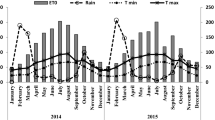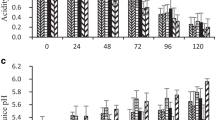Abstract
Biochemical and nutritional changes were studied during the ripening process of three Opuntia morphospecies with different ripening behavior: Naranjona (O. ficus-indica), Blanca Cristalina (Opuntia sp.), and Esmeralda (Opuntia sp.) of early, early-intermediate, and intermediate-late ripening, respectively. In loss of fresh weight, Naranjona showed the highest values, while in Blanca Cristalina and Esmeralda, a discrete weight loss was found. No significant differences were found among morphospecies in soluble solids, total titratable acidity and pH during the postharvest days. Blanca Cristalina and Esmeralda showed an increase in the content of carotenoids, while these diminished in Naranjona. The cell wall enzymes evaluated showed particular behaviors during the ripening of each morphospecies suggesting a fine biochemical control and not a clear relationship between fruit softening and enzyme activity. This study provides basic information on prickly pear ripening, in order to understand this process for its control and for improving shelf life.
Similar content being viewed by others
References
El-kossori RD, Villaume C, Boustani E, Sauvarie Y, Méjean L (1998) Composition of pulp, skin, seeds of prickly pears fruit (Opuntia ficus-indica sp.). Plant Foods Hum Nutr 52: 263–270.
Sáenz C (2000) Processing technologies and alternative for cactus pear (Opuntia spp) fruits and cladodes. J Arid Environ 46: 209–225.
Pimienta-Barrios E (1994) Prickly pear (Opuntia spp): A valuable fruit crop for semi-arid lands of Mexico. J Arid Environ 28: 1–11.
Carrillo-López A, Cruz-Hernández A, Cárabez-Trejo A, Guevara-Lara F, Paredes-López O (2002) Hydrolytic activity and ultraestructural changes in fruit skins from two prickly pear (Opuntia sp.) varieties during storage. J Agric Food Chem 50: 1681–1685.
Huber DJ (1983) The role of cell wall hydrolases in fruit softening. Hort Rev 5: 169–219.
Seymour GB, Gross KC (1996) Cell wall disassembly and fruit softening. Postharvest News Inform 7: 45N–52N.
AOAC (1994) Official Methods of Analysis, Chap 45. Washington, DC: Association of Official Analytical Chemists, pp 4–5.
Delgado-Vargas F, Paredes-López O (1996) Correlation of HPLC and AOAC methods to assess the All- trans-Lutein content in marigold flowers. J Sci Food Agric 72: 283–290.
AOAC (1999) Official Methods of Analysis. Chap 4. Washington: Association of Official Analytical Chemists, pp 34–36.
Barrett DM, Gonzalez C (1994) Activity of softening enzymes during cherry maturation. J Food Sci 59: 574–577.
Hagerman AE, Austin PJ (1986) Continuos spectrophotometric assay for plant pectin methyl esterase. J Agric Food Chem 34: 440–444.
Gross KC (1982) A rapid and sensitive spectrophotometric method for assaying polygalacturonase using 2-cyanocetamide. Hort Sci 17: 933–934.
Pressey R (1983) β-Galactosidases in ripening tomatoes. Plant Physiol 71: 933–934.
Kader AA (1992) Postharvest Technology of Horticultural Crops. Oakland, CA: University of California Special Publication 3311, p 296.
Sáenz C, Estévez, Sepúlveda E, Mecklenburg S (1998) Cactus pear fruit: A new source for natural sweetener. Plant Foods Hum Nutr 52: 141–149.
Stintzing FC (1999) Partial synthese und analytik von betaxanthinen in früdigr chten von Opuntia ficus-indica. Diploma thesis. Sttutgart, Germany: Hohenheim University, Institute of Food Technology, Hohenheim.
Askar A, El-Samahy SK (1981) Chemical composition of prickly pear fruits. Deut Lebensm-Rundsch 77: 279–281.
Sawaya WN, Khalil JK, Al-Mohammad MM (1983) Nutritive value of prickly pear seeds, Opuntia ficus-indica. Plant Foods Hum Nutr 33: 91–97.
Sepúlveda E, Sáenz C (1990) Chemical and physical characteristics of prickly pear (Opuntia ficus indica) pulp. Rev Agroquím Tecnol Alim 30: 551–555.
Ketsa S, Chidtragool S, Klein DJ, Lurie S (1998) Effect of heat treatment on changes in softening, pectic substances and activities of polygalacturonase, pectinesterase, and β-galactosidase of ripening mango. J Plant Physiol 153: 457–461.
Barka ES, Kalantari S, Makhlouf J, Arul J (2000) Impact of UV-C irradiation on the cell wall-degrading enzymes during ripening of tomato (Lycopersicon esculentum L.) fruit. J Agric Food Chem 48: 667–671.
Jen JJ, Robinson ML (1984) Pectolytic enzymes in sweet bell peppers (Capsicum annuum L.). J Food Sci 49: 1085–1087.
Ross GS, Redgwell RJ, MacRae EA (1993) Kiwifruit β-galactosidase: Isolation and activity against specific fruit cell-wall polysaccharides. Planta 189: 499–506.
Author information
Authors and Affiliations
Corresponding author
Rights and permissions
About this article
Cite this article
Hernández-Pérez, T., Carrillo-López, A., Guevara-Lara, F. et al. Biochemical and Nutritional Characterization of Three Prickly Pear Species with Different Ripening Behavior. Plant Foods Hum Nutr 60, 195–200 (2005). https://doi.org/10.1007/s11130-005-8618-y
Issue Date:
DOI: https://doi.org/10.1007/s11130-005-8618-y




